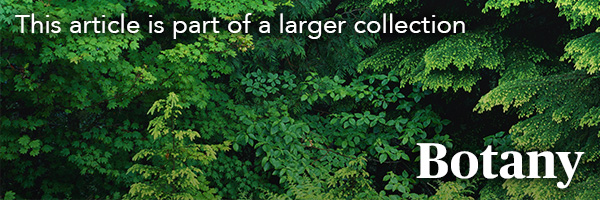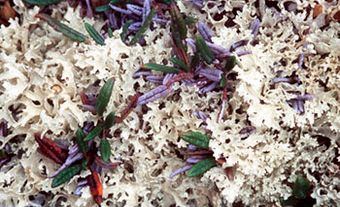
Douglas maple leaves have three to five lobes and their maple keys are paired in a V-shape.
Description
Maples found in Canada range from trees 40 metres or more tall (e.g., bigleaf maple, Acer macrophyllum) to shrubs less than 10 metres high (e.g. vine maple, Acer circinatum, and mountain maple, A. spicatum). Maples are generally deciduous, with light-coloured, straight-grained wood. The leaves grow in pairs opposite one another at the stem nodes. The leafstalks are long and slender, and the blades palmately veined, meaning each has several main veins, all extending from the same point at the base of the leaf. While most maple leaves are single-bladed, with three to nine pointed lobes, the Manitoba maple (Acer negundo) has compound leaves, with three to nine leaflets arranged along a central stalk.

Vine maple leaves have seven to nine lobes and turn bright red or yellow in the fall.
Maples are famous for their brilliant fall colours. Most, especially those celebrated in Canada’s eastern hardwood forests, display brilliant reds and oranges. On the west coast, however, the bigleaf maple, equally vibrant, turns bright golden yellow. The fall colours are due to the production of pigments called anthocyanins (responsible for the red colours) and/or the presence of carotenoids (orange and yellow) in the leaves after the green chlorophyll breaks down.
In spring, the maple leaf-buds start to expand, often at the same time as the tree’s blooming flowers. The flowers, pollinated by wind or by insects, are clustered, whitish to light yellow-green, or sometimes red in colour, depending on the species. Male and female flowers are separate, within the same cluster, in separate clusters, or on separate trees, again depending on the species. The fruits (known as samaras or maple keys) are produced in winged pairs (rarely in threes). Each encloses a seed and is dispersed by wind. The angle between the wings of a maple key varies with different species.
Distribution and Habitat
Of the 125 Acer species found worldwide, over two-thirds grow in China; 10 are native to Canada, and others are grown as ornamentals, with some (such as Norway maple, A. platanoides), becoming naturalized in parts of Canada. Maples grow in a range of habitats and at varying altitudes but prefer deep, moist, fertile soils. They are a major constituent of many temperate forests.
Canada’s Maple Species
|
Species |
Description |
Habitat and Range |
| Acer circinatum (vine maple) | Small tree or multi-stemmed shrub; leaves have seven to nine lobes, and turn bright red or golden in the fall; white flowers grow in small clusters; maple key wings are wide apart. | Damp, open woods and streamsides, from southwestern British Columbia to northern California. |
| Acer glabrum (Douglas or Rocky Mountain maple) | Small tree or multi-stemmed shrub; leaves have three to five lobes, and turn yellow to red in the fall; yellowish green flowers grow in small clusters; maple key wings are paired in a V-shape. | Streambanks, gravelly slopes and open woods from British Columbia (except northeastern BC) to Alberta foothills and south to the US, mainly from Oregon to Utah. |
| Acer macrophyllum (bigleaf maple) | Tall, spreading tree; dark green leaves are very large with five lobes, and turn golden yellow in the fall; yellowish flowers grow in drooping clusters; maple keys are hairy with wings usually angled at about 45°.
|
Moist woodlands and prairies of western North America, from British Columbia’s central coast south to California. |
| Acer negundo (Manitoba maple or box-elder) | Small spreading tree; leaves are compound, each with three to seven (rarely nine) leaflets, and turn yellow in the fall; white flowers are densely clustered and without petals; maple key wings are paired in V-shape. | Moist soils, from southern Saskatchewan, Manitoba and Ontario south to Florida and New Mexico. (Also naturalized in southern British Columbia and elsewhere in Canada, as well as Europe.) |
| Acer nigrum (black maple) | Medium-sized, dense-crowned tree; leaves have three lobes and are long-stalked, the blades are hairy beneath, and turn orange or yellow-brown in the fall; yellowish-green flowers grow in hanging clusters; maple key wings are only slightly angled. | Shade tolerant, growing in moist floodplains and bottomlands, in southeastern hardwood forests from Ottawa to Montreal, and south in US to Tennessee. |
| Acer pensylvanicum (striped maple or moosewood) | Small, shrub-like tree with distinctive vertically striped bark; leaves are broad and soft with three shallow lobes, and turn golden yellow in the fall; light yellow flowers grow in drooping clusters, with male and female flowers on different trees; maple key wings are angled at about 145°. | Shade tolerant, growing in cool, moist areas from Nova Scotia and Quebec’s Gaspe Peninsula west to Saskatchewan, and south in the US as far as Georgia. |
| Acer rubrum (red maple) | Medium-sized tree; leaves grow up to 15 cm long, with three to five sharply-toothed lobes, and turn brilliant red in the fall; twigs, buds, flowers are bright red; maple key wings are angled at about 60°.
|
A variety of habitats from swamps to dry woods, widely ranging over eastern North America. |
| Acer saccharum (sugar maple) | Large branching, straight-trunked tree; leaves have five pointed lobes, and turn brilliant red in the fall; flowers are tiny, bell-shaped, and long-stalked; clustered maple keys have U-shaped wings that grow slightly apart. | Common in hardwood forests in deep, well-drained soils, from Ontario to Maritimes and south in the US to Georgia and Kansas. |
| Acer saccharinum (silver maple) | Medium sized, short-trunked, spreading tree up to 35 m high; leaves light green above, silvery-white below, and deeply lobed. They turn yellowish or brown in the fall; flowers are densely clustered; maple keys are very large, with wings up to 5 cm long. | Along waterways and rich, moist bottom lands in southeastern Great Lakes and St. Lawrence forest region and through most of eastern US. |
| Acer spicatum (mountain maple) | Small tree or large shrub with short, crooked trunk, often multi-stemmed; leaves are yellowish green above and whitish below, with three lobes, and turn yellow or brown in the fall; light yellow flowers grow in dense, upright spikes; maple key
wings are angled at about 45°.
|
Forest understory, hillsides and stream edges; Saskatchewan east to Newfoundland, south to northeastern US. |
Wildlife
Maples are important food sources for wildlife; the flower nectar and pollen is sought by bees, flies and other insects. Hummingbirds and other birds also like maple flower nectar. Maple fruits and seeds are eaten by birds, squirrels, chipmunks and mice, and the young twigs and leaves are eaten by deer and moose.
Indigenous Peoples
Maples are well known to Indigenous peoples in Canada, and are named in many Indigenous languages. While all maple tree sap contains sugar, the sap of the sugar maple has the highest concentration. It has been used by virtually all Indigenous peoples within the tree’s range, being rendered into syrup and sugar by Haudenosaunee, Anishinaabe, Wolastoqiyik (Maliseet), Mi’kmaq, Innu, and Algonquin as well as various American groups. There is good evidence that Indigenous peoples of the Eastern Woodlands were the first to develop maple sugaring technologies; when Europeans arrived, the First Nations sold large quantities of maple sugar to the fur trading posts. As well as providing sap for sugar and syrup, some maples have edible inner bark that was formerly eaten fresh or dried, or powdered and used as a thickener in soups or as in ingredient in breads.
Maples yield wood used by Indigenous peoples for many purposes, from basketry to fish traps, snowshoes, bows, spear handles, paddles, and spindle whorls. The fibrous inner bark of maples can be turned into baskets, ropes and even clothing, and the large leaves as a surface for laying food on. Maples have also been used medicinally to treat various ailments, from coughs and tuberculosis to dysentery.
Uses
Canada is the leading producer of maple syrup and other maple food products in the world, with 90 per cent of Canadian maple syrup production coming from Quebec (as of early 2018). The hard, fine-grained wood of the larger Canadian maples is widely used for manufacturing furniture, flooring, and interior woodwork, as well as for bowls, toys, musical instruments, plywood and veneer. Some trees grow burls and produce wood with contorted grain patterns – known as “bird’s eye maple” – that is in demand by woodworkers. Maple species are also widely grown as ornamental trees on city streets and in yards across Canada, contributing aesthetic beauty, shade, erosion control and surface water management.
Threats
Climate change, resulting in warmer, drier weather overall, is perhaps the greatest threat to Canadian maples. As well, insect pests such as the introduced Asian Long-Horn Beetle, have caused significant damage to maples.
When did the Apple tree arrive in Canada and why do some trees in B.C live over a thousand years? A quick peek into some of the history kept by our land’s oldest living knowledge keepers — trees.
Note: The Secret Life of Canada is hosted and written by Falen Johnson and Leah Simone Bowen and is a CBC original podcast independent of The Canadian Encyclopedia.

 Share on Facebook
Share on Facebook Share on X
Share on X Share by Email
Share by Email Share on Google Classroom
Share on Google Classroom





